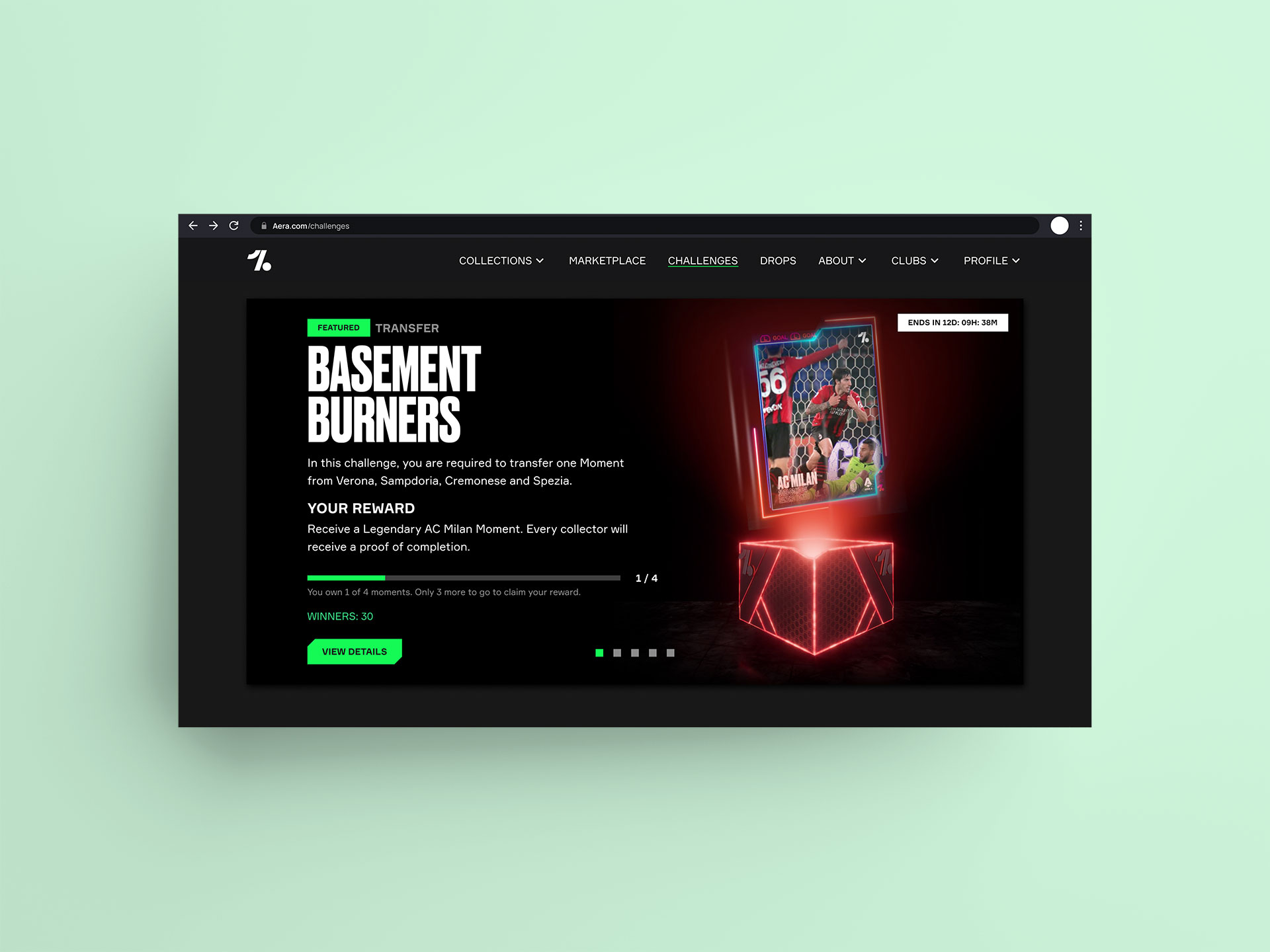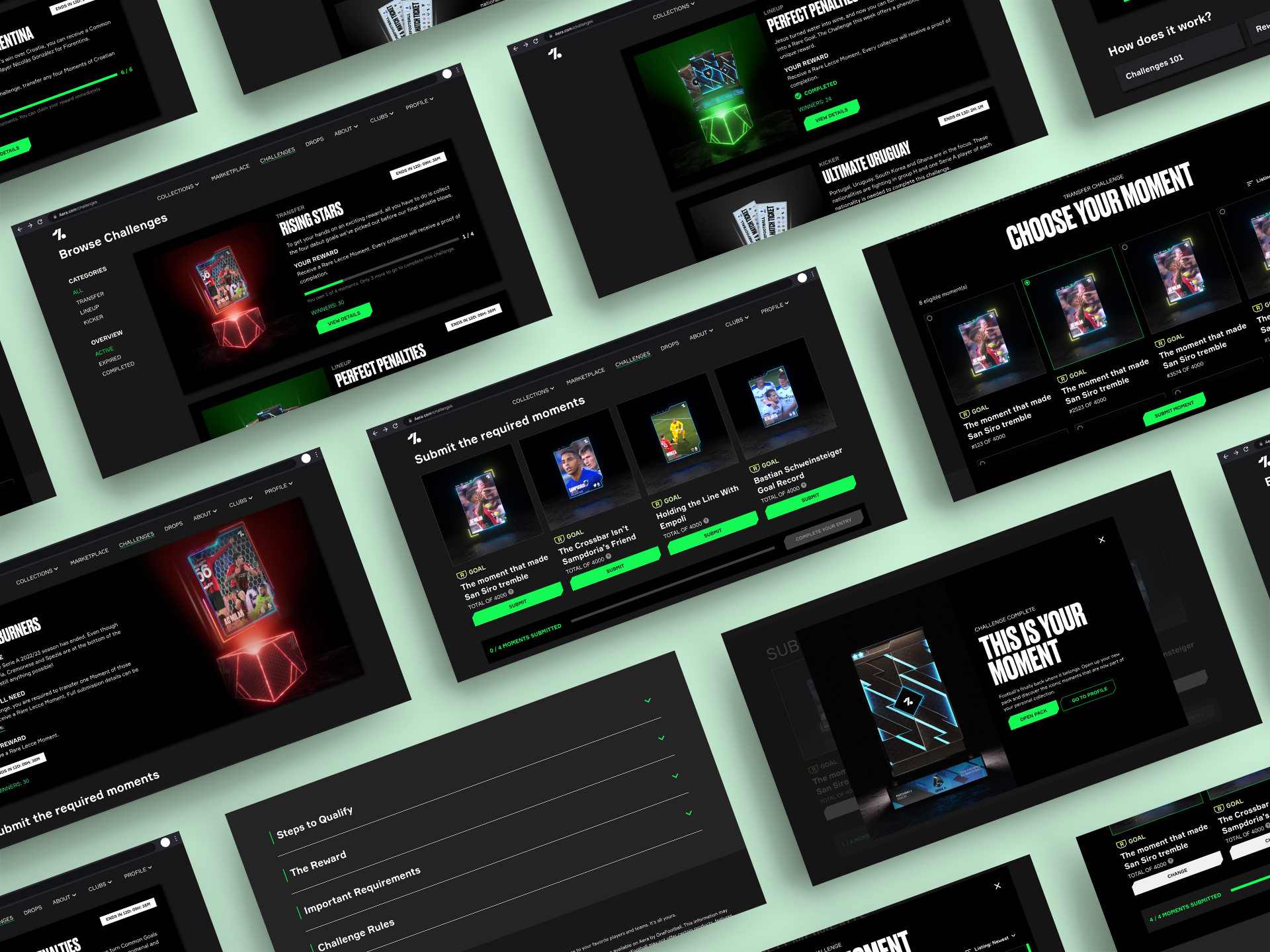Burning NFT's
made simple
About Aera
Aera by OneFootball is a digital collectibles (NFT) platform featuring the biggest clubs, leagues, federations and players in the football industry.Project Challenge
Background
Burning NFTs, which are tokens stored on a blockchain, is the process of permanently removing a token from circulation. This can be done to eliminate unsold or problematic inventory from an NFT drop, or it can be used to engage fans through “upgrades” that replace an original NFT with something else.
The Problem
At OneFootball, we wanted to burn unsold NFT's that were too high in circulation by rewarding fans with packs of NFT's. The concept was to get users to burn a few moments and recieve a pack that had higher odds in more valuable NFT's within the pack. We already had a feature called "Challenges" which gave users the ability to earn packs by collecting different NFT's but no mechanics to burn NFT's to earn a pack. As the designer, I was tasked with finding the right solution for the feature.
The Approach
I set out the task of building the feature as follows:
- Conducting research
- Design solutions
- Validating designs
- Setting OKR's
- Setting up data tracking to measure success
- QA before launch
01
Research
Objective
In order to gather insights about user needs and pain points, I conducted surveys and user tests to gather insights about how users interact with NFT's and what they expect from a website that facilitates the burning of NFT's.
Surveys
The core target market for burning NFT's was users with a high engagement on our platform and are existing users rather than new users. With this in mind, I created an online survey and distributed it through our Discord channel to gather information about user behavior and expectations. The survey asked questions about how often they buy/sell/trade NFT's, and what they look for in a website that facilitates the burning of NFT's. The following key takeways were taken into consideration for my design solution:
- Make the process of burning NFT's as simple as possible with clear instructions
- Pack odds should be included so that users know the chances of winning different rarities of NFT's
- Include instructions on how to qualify for the reward
User Testing
I conducted user tests with a prototype of the website to observe how users interacted with the interface and identify usability issues. The user tests helped me refine the design and ensure that the process of burning NFT's was as seamless as possible. The user tests were conducted with five participants, all of whom use the website to buy/sell/trade NFT's on a regular basis ranging from one to three times a week. The following key takeways were taken into consideration for my design solution:
- 60% of users were unsure about what rewards they could receive on the challenge hub page before going into the challenge.
- 20% of users wanted see their progress of the challenge on the challenge hub page without having to navigate into the challenge to view their progress
- 60% of users wanted to change the visual hierarchy by moving the information regarding steps to qualify and the reward pack odds lower than the NFT selection element on the challenge page
- 40% of users found it difficult to navigate back and forth from selecting their NFT to burn and the main challenge page
02
Designs
Based on the competitor analysis and user interviews, I addressed the pain points by including the following features:
- Added the reward and progress indicator on the challenge hub page
- Moved all the information regarding steps to qualify, reward pack odds, requirements and rules to the bottom of the page and into accordions to reduce the cognitive load
- Changed the selection of NFT's to burn into a modal on the page to avoid the user navigating back and forth



03
Validation
The design prototype was tested again with the same group of users to identify any other usability issues and to determine whether the design met the user's needs.
Key Takeaways
The user testing recieved positive results with only one user requesting to move the steps to qualify back to the top. With a small sample size of user testing, we decided to use data to track the engagement of the accordions to help us conclude on whether to change the visual hierarchy or not.
04
Metrics
OKR's
The following OKR's were set for the project together with the product manager and lead engineer:
- Increase the number of users who burn NFT's by 20% within 3 months. The primary objective of the website is to encourage users to burn NFT's, so an increase in the number of users who burn NFT's would be a key KPI.
- Increase the number of repeat users by 30% within 12 months. To ensure the long-term success of the feature, we would measure the number of users who return to burn NFT's multiple. times
Data Tracking
To measure the success of the website, the following data will be tracked:
- Number of users who complete the process of burning NFT's and receive a pack of NFT's.
- Number of users who visit the website and engage with the content.
- Number of users who return to the website to burn NFT's multiple times.
05
Conclusion
In conclusion, designing a feature that allows users to burn NFT's in exchange for a pack of NFT's rewards required a human-centered design approach. By conducting user research and identifying key pain points, we developed solutions that addressed user needs and expectations. By measuring the right KPI's and tracking the right metrics, we can ensure the success of the feature and achieve our objectives.
However, due to mass layoffs at OneFootball, I could not track the data to iterate and improve the feature to ensure we meet our OKR targets.

